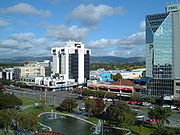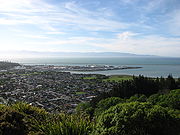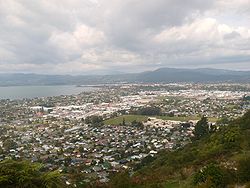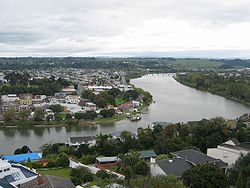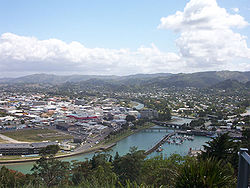
List of cities in New Zealand
Encyclopedia
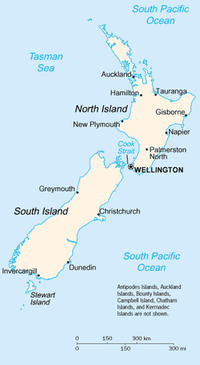
New Zealand
New Zealand is an island country in the south-western Pacific Ocean comprising two main landmasses and numerous smaller islands. The country is situated some east of Australia across the Tasman Sea, and roughly south of the Pacific island nations of New Caledonia, Fiji, and Tonga...
. Before 1989, a borough council with more than 20,000 people could be proclaimed a city. The boundaries of councils tended to follow the edge of the built-up area, so little distinction was made between the urban area and the local government area.
In 1989, the structure of the local governments in New Zealand was significantly reorganized. The new district councils and city councils were nearly always much larger geographically, and they covered both urban land and the surrounding rural land. Many locations that once had had a "city council" are now being governed by a "district council".
The word "city" began to be used in a less formal sense to describe the urban areas of New Zealand
Urban areas of New Zealand
Statistics New Zealand defines New Zealand urban areas for statistical purposes. The urban areas comprise cities, towns and other 'conurbations' of a thousand people or more. In combination, the urban areas of the country constitute New Zealand's urban population...
independent of local body boundaries. This informal usage is jealously guarded. The district government of the town of Gisborne
Gisborne, New Zealand
-Economy:The harbour was host to many ships in the past and had developed as a river port to provide a more secure location for shipping compared with the open roadstead of Poverty Bay which can be exposed to southerly swells. A meat works was sited beside the harbour and meat and wool was shipped...
, for example, adamantly described itself as the first "city" in the world to see the new millennium. However, Gisborne is governed by a "district council", but its status as a city is not generally disputed in New Zealand.
Urban areas by population
The populations given in the table below are provisional New Zealand resident populations, and they refer to the entire urban area, unless otherwise stated.| Rank (population) | Urban area | Population | Area (km²) |
Population Density (people/km²) |
Notes |
|---|---|---|---|---|---|
| 1 | Auckland Auckland The Auckland metropolitan area , in the North Island of New Zealand, is the largest and most populous urban area in the country with residents, percent of the country's population. Auckland also has the largest Polynesian population of any city in the world... |
1,086 | |||
| 2 | Christchurch Christchurch Christchurch is the largest city in the South Island of New Zealand, and the country's second-largest urban area after Auckland. It lies one third of the way down the South Island's east coast, just north of Banks Peninsula which itself, since 2006, lies within the formal limits of... |
608 | |||
| 3 | Wellington Wellington Wellington is the capital city and third most populous urban area of New Zealand, although it is likely to have surpassed Christchurch due to the exodus following the Canterbury Earthquake. It is at the southwestern tip of the North Island, between Cook Strait and the Rimutaka Range... |
444 | 1. | ||
| 4 | Hamilton Urban Area Hamilton Urban Area The Hamilton Urban Area is a New Zealand urban area in the Waikato Region. It is the fourth largest urban area in the country with a population of . At its centre is Hamilton City, New Zealand's fourth largest territorial authority... |
877 | 2. | ||
| 5 | Napier-Hastings Urban Area Napier-Hastings Urban Area The Napier-Hastings Urban Area is a New Zealand urban area that covers the twin cities of Napier and Hastings. It is the fifth largest urban area in the country with a population of over 128,600... |
375 | 3. | ||
| 6 | Tauranga Tauranga Tauranga is the most populous city in the Bay of Plenty region, in the North Island of New Zealand.It was settled by Europeans in the early 19th century and was constituted as a city in 1963... |
178 | |||
| 7 | Dunedin Dunedin Dunedin is the second-largest city in the South Island of New Zealand, and the principal city of the Otago Region. It is considered to be one of the four main urban centres of New Zealand for historic, cultural, and geographic reasons. Dunedin was the largest city by territorial land area until... |
255 | |||
| 8 | Palmerston North Palmerston North Palmerston North is the main city of the Manawatu-Wanganui region of the North Island of New Zealand. It is an inland city with a population of and is the country's seventh largest city and eighth largest urban area. Palmerston North is located in the eastern Manawatu Plains near the north bank... |
178 | |||
| 9 | Nelson Nelson, New Zealand Nelson is a city on the eastern shores of Tasman Bay, and is the economic and cultural centre of the Nelson-Tasman region. Established in 1841, it is the second oldest settled city in New Zealand and the oldest in the South Island.... |
146 | |||
| 10 | Rotorua Rotorua Rotorua is a city on the southern shores of the lake of the same name, in the Bay of Plenty region of the North Island of New Zealand. The city is the seat of the Rotorua District, a territorial authority encompassing the city and several other nearby towns... |
89 | |||
| 11 | New Plymouth New Plymouth New Plymouth is the major city of the Taranaki Region on the west coast of the North Island of New Zealand. It is named after Plymouth, Devon, England, from where the first English settlers migrated.... |
112 | |||
| 12 | Whangarei Whangarei Whangarei, pronounced , is the northernmost city in New Zealand and the regional capital of Northland Region. Although commonly classified as a city, it is officially part of the Whangarei District, administered by the Whangarei District Council a local body created in 1989 to administer both the... |
133 | |||
| 13 | Invercargill Invercargill Invercargill is the southernmost and westernmost city in New Zealand, and one of the southernmost cities in the world. It is the commercial centre of the Southland region. It lies in the heart of the wide expanse of the Southland Plains on the Oreti or New River some 18 km north of Bluff,... |
123 | |||
| 14 | Whanganui Whanganui Various places in New Zealand are called Whanganui:*Whanganui, a city at the mouth of the Whanganui River, also often spelled "Wanganui", Manawatu-Wanganui Region*Whanganui District, Manawatu-Wanganui Region*Whanganui Island, Waikato Region... (Wanganui) |
105 | |||
| 15 | Gisborne Gisborne, New Zealand -Economy:The harbour was host to many ships in the past and had developed as a river port to provide a more secure location for shipping compared with the open roadstead of Poverty Bay which can be exposed to southerly swells. A meat works was sited beside the harbour and meat and wool was shipped... |
85 |
Notes:
- Kapiti CoastKapiti CoastThe Kapiti Coast is the name of the section of the coast of the south-western North Island of New Zealand that is north of Wellington and opposite Kapiti Island. It falls under the jurisdiction of the Wellington Regional Council...
is the only urban area not listed by the Statistics New ZealandStatistics New ZealandStatistics New Zealand is the national statistical office of New Zealand.-Organisation:New Zealand's Minister of Statistics is Maurice Williamson who serves as a member of the New Zealand House of Representatives and holds several other posts within government...
organization. The Kapiti Coast District includes the townshipTownshipThe word township is used to refer to different kinds of settlements in different countries. Township is generally associated with an urban area. However there are many exceptions to this rule. In Australia, the United States, and Canada, they may be settlements too small to be considered urban...
s of PaekakarikiPaekakarikiPaekakariki is a town in the Kapiti Coast District in the south-western North Island of New Zealand. It is 22 km north of Porirua and 45 km north-east of Wellington, the nation's capital city....
, RaumatiRaumatiRaumati collectively refers to two neighbouring places on the Kapiti Coast of New Zealand's North Island. They are located 50-60 km north-east of Wellington, and immediately to the south-west of the larger town of Paraparaumu. The Maungakotukutuku area is located immediately behind Raumati...
, ParaparaumuParaparaumuParaparaumu is a town in the south-western North Island of New Zealand. It lies in the Kapiti Coast, 50 kilometres north of the nation's capital city, Wellington....
; Paraparaumu BeachParaparaumu BeachParaparaumu Beach is situated to the west of the 'township' of Paraparaumu, located 50 km north of Wellington, New Zealand. The area overlooks Kapiti Island....
, and WaikanaeWaikanaeWaikanae is a small town on New Zealand's Kapiti Coast. The name is a Māori word meaning "The waters of the yellow eyed mullet". Another settlement called Waikanae Beach exists near Gisborne on the east coast of the North Island of New Zealand....
; and the village of Pekapeka, and is not considered to be a city by Statistics New Zealand. The Kapiti Coast is considered by most Wellingtonians as being part of the Greater Wellington Area - though not by Statistics New Zealand. Hundreds of people here commute daily to Wellington for work, and the suburban commuter railroad network ends in the Kapiti District. If Kapiti were added to Wellington the total population of the Wellington Urban Area would be approximately 430,000. - The population for the Hamilton urban zone is , the CambridgeCambridge, New ZealandCambridge is a town in the Waikato region of the North Island of New Zealand. Situated 24 kilometres southeast of Hamilton, on the banks of the Waikato River, Cambridge is known as "The Town of Trees & Champions".In the 1840s Cambridge had a Maori population but in the 1850's missionaries and...
urban zone is and the Te AwamutuTe AwamutuTe Awamutu is a town in the Waikato in the North Island of New Zealand. It is the council seat of the Waipa District and serves as a service town for the farming communities which surround it...
urban zone is . - The population figures for the Hastings urban zone is , and for Napier .
- BlenheimBlenheim, New ZealandBlenheim is the most populous town in the region of Marlborough, in the north east of the South Island of New Zealand, and the seat of the regional council. It has a population of The area which surrounds the town is well known as a centre of New Zealand's wine industry...
is sometimes referred to as a city, especially by locals, although its (former) borough council was never proclaimed a city. - TimaruTimaruTimaruUrban AreaPopulation:27,200Extent:Former Timaru City CouncilTerritorial AuthorityName:Timaru District CouncilPopulation:42,867 Land area:2,736.54 km² Mayor:Janie AnnearWebsite:...
once had a city council, but it is now administered as part of a district council. It is classified as a secondary urban area by Statistics New Zealand. - PukekohePukekohePukekohe is a town in the Auckland Region of the North Island of New Zealand. Located at the southern edge of the Auckland Region, it is approximately 50 kilometres south of Auckland City, between the southern shore of the Manukau Harbour and the mouth of the Waikato River. The hills of Pukekohe...
, a settlement not far south of Auckland, has an estimated population of . - TaupoTaupoTaupo is a town on the shore of Lake Taupo in the centre of the North Island of New Zealand. It is the seat of the Taupo District Council and lies in the southern Waikato Region....
in the central North Island and with an estimated population of is rarely referred to as a city. - MastertonMastertonMasterton is a large town and local government district in the Wellington Region of New Zealand. It is the largest town in the Wairarapa, a region separated from Wellington by the Rimutaka ranges...
, the main centre in the Wairarapa, is rarely referred to as a city. It has an estimated population of . - TokoroaTokoroaTokoroa is the third-largest town in the Waikato region of the North Island of New Zealand and largest settlement in the South Waikato district. Located 30 km southwest of Rotorua, close to the foot of the Mamaku Ranges, it is mid-way between Taupo and Hamilton on State Highway One...
in the South Waikato district was long expected to become a city when its population continued to grow past 18,000 during the 1980s. However, with the fallback in the forestry industry, Tokoroa's main industry, many jobs were lost and Tokoroa's population declined. It now has residents. - LevinLevin, New ZealandLevin is a town in the Manawatu-Wanganui region of New Zealand, and is the largest town in the Horowhenua district. It is 90 kilometres north of Wellington, 50 kilometres south of Palmerston North, and two kilometres to the east of Lake Horowhenua....
, the main centre in the Horowhenua district, with an estimated population of nearly 20,000 is also not considered to be a city.
City councils
The populations given are the Statistics New Zealand estimated resident population| City Council | Population | First Proclaimed | Ranking (size) |
|---|---|---|---|
| Auckland Auckland Council The Auckland Council is the council for the Auckland Region in New Zealand. It began operating on 1 November 2010, combining the functions of the existing regional council and the region's seven previous city and district councils into one "super council" or "super city" governed by a mayor, 20... |
1871 | 1 | |
| Hamilton Hamilton, New Zealand Hamilton is the centre of New Zealand's fourth largest urban area, and Hamilton City is the country's fourth largest territorial authority. Hamilton is in the Waikato Region of the North Island, approximately south of Auckland... |
1936 | 4 | |
| Tauranga Tauranga Tauranga is the most populous city in the Bay of Plenty region, in the North Island of New Zealand.It was settled by Europeans in the early 19th century and was constituted as a city in 1963... |
1963 | 6 | |
| Napier Napier, New Zealand Napier is a New Zealand city with a seaport, located in Hawke's Bay on the eastern coast of the North Island. The population of Napier is about About 18 kilometres south of Napier is the inland city of Hastings. These two neighboring cities are often called "The Twin Cities" or "The Bay Cities"... |
1950 | 9 | |
| Palmerston North Palmerston North Palmerston North is the main city of the Manawatu-Wanganui region of the North Island of New Zealand. It is an inland city with a population of and is the country's seventh largest city and eighth largest urban area. Palmerston North is located in the eastern Manawatu Plains near the north bank... |
1930 | 8 | |
| Porirua Porirua Porirua is a city in the Wellington Region of New Zealand, immediately north of the city of Wellington, with their central business districts 20 km apart. A large proportion of the population commutes to Wellington, so it may be considered a satellite city. It almost completely surrounds... |
1965 | 11 | |
| Upper Hutt Upper Hutt Upper Hutt is a satellite city of Wellington. It is New Zealand's smallest city by population, the second largest by land area. It is in Greater Wellington.-Geography:Upper Hutt is 30 km north-east of Wellington... |
1966 | 13 | |
| Lower Hutt Lower Hutt Lower Hutt is a city in the Wellington region of New Zealand. Its council has adopted the name Hutt City Council, but neither the New Zealand Geographic Board nor the Local Government Act recognise the name Hutt City. This alternative name can lead to confusion, as there are two cities in the... |
1941 | 7 | |
| Wellington Wellington Wellington is the capital city and third most populous urban area of New Zealand, although it is likely to have surpassed Christchurch due to the exodus following the Canterbury Earthquake. It is at the southwestern tip of the North Island, between Cook Strait and the Rimutaka Range... |
1870 | 3 | |
| Nelson Nelson, New Zealand Nelson is a city on the eastern shores of Tasman Bay, and is the economic and cultural centre of the Nelson-Tasman region. Established in 1841, it is the second oldest settled city in New Zealand and the oldest in the South Island.... |
1874 | 12 | |
| Christchurch Christchurch Christchurch is the largest city in the South Island of New Zealand, and the country's second-largest urban area after Auckland. It lies one third of the way down the South Island's east coast, just north of Banks Peninsula which itself, since 2006, lies within the formal limits of... |
1868 | 2 | |
| Dunedin Dunedin Dunedin is the second-largest city in the South Island of New Zealand, and the principal city of the Otago Region. It is considered to be one of the four main urban centres of New Zealand for historic, cultural, and geographic reasons. Dunedin was the largest city by territorial land area until... |
1865 | 5 | |
| Invercargill Invercargill Invercargill is the southernmost and westernmost city in New Zealand, and one of the southernmost cities in the world. It is the commercial centre of the Southland region. It lies in the heart of the wide expanse of the Southland Plains on the Oreti or New River some 18 km north of Bluff,... |
1930 | 10 |
Many cities were reorganised into districts by the Local Government Commission in 1989 under the Local Government Act 1974
Local Government Act 1974 (NZ)
The Local Government Act 1974 of New Zealand consolidated the previous law relating to local government that applied to territorial local authorities, regional and district council bodies in New Zealand.The Act made provision for the establishment of:...
, for example, Timaru. The most recently proclaimed city is Tauranga, which became a city, for the second time, from 1 March 2004. Another former city is Rotorua
Rotorua
Rotorua is a city on the southern shores of the lake of the same name, in the Bay of Plenty region of the North Island of New Zealand. The city is the seat of the Rotorua District, a territorial authority encompassing the city and several other nearby towns...
. Some present cities, such as Christchurch
Christchurch
Christchurch is the largest city in the South Island of New Zealand, and the country's second-largest urban area after Auckland. It lies one third of the way down the South Island's east coast, just north of Banks Peninsula which itself, since 2006, lies within the formal limits of...
(1862 and 1868) and Invercargill (1930 and 1991), have been declared cities more than once.
Under Section 27 of the Local Government Act 2002, a district may become a city by either a reorganisation scheme with the Local Government Commission, or under Section 27(1) it may apply for a change in status under Schedule 3, Clause 7. The new city must have 'a population of not less than 50,000 persons', be 'predominantly urban' and 'a distinct entity and a major centre of activity within the region
Regions of New Zealand
The region is the top tier of local government in New Zealand. There are 16 regions of New Zealand. Eleven are governed by an elected regional council, while five are governed by territorial authorities which also perform the functions of a regional council and thus are known as unitary authorities...
' (or regions) that it is encompassed by. Existing cities are grandfathered under Schedule 2, Part 2 of the Act. The only new city council so far under this section is the Tauranga City Council, from 1 March 2004.
Previously, under Section 37L of the Local Government Act 1974, new cities could only be formed from a reorganisation scheme. The same criteria were used. The last city to be constituted under this section was Invercargill, which was re-reorganised into a city in 1991.
In 1991 the Lower Hutt City Council became the Hutt City Council by a special Act of Parliament http://www.legislation.govt.nz/act/local/1991/0002/latest/DLM80144.html?search=qs_act_hutt+city+council_resel&sr=1 that which did not change the name http://www.legislation.govt.nz/libraries/contents/om_isapi.dll?clientID=3288460868&hitsperheading=on&infobase=pal_localprivate.nfo&jump=a1991-002l%2fs.2&softpage=DOC#JUMPDEST_a1991-002l/s.2 of the city of Lower Hutt
Lower Hutt
Lower Hutt is a city in the Wellington region of New Zealand. Its council has adopted the name Hutt City Council, but neither the New Zealand Geographic Board nor the Local Government Act recognise the name Hutt City. This alternative name can lead to confusion, as there are two cities in the...
; the city's coat of arms
Coat of arms
A coat of arms is a unique heraldic design on a shield or escutcheon or on a surcoat or tabard used to cover and protect armour and to identify the wearer. Thus the term is often stated as "coat-armour", because it was anciently displayed on the front of a coat of cloth...
still refers to the City of Lower Hutt.
Cities during provincialism, 1852 to 1876
During provincialism in New ZealandProvinces of New Zealand
The Provinces of New Zealand existed from 1841 until 1876 as a form of sub-national government. They were replaced by counties, which were themselves replaced by districts.Following abolition, the provinces became known as provincial districts...
, from 1852 until abolition in 1876, there was no uniform system of local authorities in New Zealand. There is thus some argument over which of the following cities was the first.
- NelsonNelson, New ZealandNelson is a city on the eastern shores of Tasman Bay, and is the economic and cultural centre of the Nelson-Tasman region. Established in 1841, it is the second oldest settled city in New Zealand and the oldest in the South Island....
(1858, by Letters Patent) - ChristchurchChristchurchChristchurch is the largest city in the South Island of New Zealand, and the country's second-largest urban area after Auckland. It lies one third of the way down the South Island's east coast, just north of Banks Peninsula which itself, since 2006, lies within the formal limits of...
(November 1862, revoked June 1868, both by provincial ordinance, and restored October 1868 by Act of Parliament) - Otago (later DunedinDunedinDunedin is the second-largest city in the South Island of New Zealand, and the principal city of the Otago Region. It is considered to be one of the four main urban centres of New Zealand for historic, cultural, and geographic reasons. Dunedin was the largest city by territorial land area until...
) (July 1865)
The Municipal Corporations Act 1876 included the first schedule of cities, with the dates they were constituted. Dunedin was the first city in New Zealand to be described in an Act of Parliament as 'City of...', something now automatic under the Local Government Act 2002.
- DunedinDunedinDunedin is the second-largest city in the South Island of New Zealand, and the principal city of the Otago Region. It is considered to be one of the four main urban centres of New Zealand for historic, cultural, and geographic reasons. Dunedin was the largest city by territorial land area until...
(4 July 1865) - ChristchurchChristchurchChristchurch is the largest city in the South Island of New Zealand, and the country's second-largest urban area after Auckland. It lies one third of the way down the South Island's east coast, just north of Banks Peninsula which itself, since 2006, lies within the formal limits of...
(28 May 1868) - WellingtonWellingtonWellington is the capital city and third most populous urban area of New Zealand, although it is likely to have surpassed Christchurch due to the exodus following the Canterbury Earthquake. It is at the southwestern tip of the North Island, between Cook Strait and the Rimutaka Range...
(16 September 1870) - Auckland (24 April 1871)
- NelsonNelson, New ZealandNelson is a city on the eastern shores of Tasman Bay, and is the economic and cultural centre of the Nelson-Tasman region. Established in 1841, it is the second oldest settled city in New Zealand and the oldest in the South Island....
(30 March 1874)
Cities, 1877 to 1989
Up to October 1989, the Local Government Commission undertook reorganisations of local government. As a result, some cities were reorganised into other cities or changed to districts, and some of these areas are still considered cities by many New Zealanders. This is a list as at circa 1986.- North Island
- WhangareiWhangareiWhangarei, pronounced , is the northernmost city in New Zealand and the regional capital of Northland Region. Although commonly classified as a city, it is officially part of the Whangarei District, administered by the Whangarei District Council a local body created in 1989 to administer both the...
(1964) - Auckland
- AucklandAuckland CityAuckland City was the city and local authority covering the Auckland isthmus and most of the islands of the Hauraki Gulf, in the North Island of New Zealand. On 1 November 2010 it was amalgamated into the wider Auckland Region under the authority of the new Auckland Council...
(1871) - East Coast BaysEast Coast BaysEast Coast Bays is the collective name for a series of small suburbs of North Shore City, in the Auckland metropolitan area of New Zealand, which line the northeast coast of the city along the shore of the Hauraki Gulf and Rangitoto Channel...
- TakapunaTakapunaTakapuna is a central, coastal suburb of North Shore City, located in the northern North Island of New Zealand, at the beginning of a south-east-facing peninsula forming the northern side of the Waitemata Harbour...
- BirkenheadBirkenhead, New ZealandBirkenhead is a suburb of Auckland, in northern New Zealand. It is located on the north shore of the Waitemata Harbour, four kilometres northwest of the Auckland city centre....
- WaitemataWaitemata CityWaitemata City was a New Zealand city in the greater Auckland area. It was formed in 1974 from the western part of the old Waitemata County, with both the County and City taking their names from Waitemata Harbour...
(1974) - Mt AlbertMount Albert, New ZealandMount Albert is a volcanic peak and suburban area in the city of Auckland, New Zealand. The suburb was Auckland's second, after Remuera, and was mostly settled by well-off families in the late 1800s and early 1900s...
- PapatoetoePapatoetoePapatoetoe is a suburb in the Auckland conurbation in northern New Zealand. One of the larger suburbs of the area commonly known as South Auckland, it is located to the northwest of central Manukau, and 18 kilometres southeast of Auckland city centre....
- Manukau (1965)
- PapakuraPapakuraThe Papakura District was the name of a local council territory in New Zealand's Auckland Region that existed from 1989 until 2010. The area made up the southernmost part of the Auckland metropolitan area....
- TamakiTamaki, New ZealandTamaki is a small suburb of the city of Auckland, in the North Island of New Zealand. It is located in the east of the city, 11 kilometres from the city centre, by the banks of the estuarial Tamaki River, which is a southern arm of the Hauraki Gulf...
- Auckland
- HamiltonHamilton, New ZealandHamilton is the centre of New Zealand's fourth largest urban area, and Hamilton City is the country's fourth largest territorial authority. Hamilton is in the Waikato Region of the North Island, approximately south of Auckland...
(1936) - New PlymouthNew PlymouthNew Plymouth is the major city of the Taranaki Region on the west coast of the North Island of New Zealand. It is named after Plymouth, Devon, England, from where the first English settlers migrated....
(1949) - TaurangaTaurangaTauranga is the most populous city in the Bay of Plenty region, in the North Island of New Zealand.It was settled by Europeans in the early 19th century and was constituted as a city in 1963...
(1963) - RotoruaRotoruaRotorua is a city on the southern shores of the lake of the same name, in the Bay of Plenty region of the North Island of New Zealand. The city is the seat of the Rotorua District, a territorial authority encompassing the city and several other nearby towns...
(1962, merged into Rotorua District, 1979) - GisborneGisborne, New Zealand-Economy:The harbour was host to many ships in the past and had developed as a river port to provide a more secure location for shipping compared with the open roadstead of Poverty Bay which can be exposed to southerly swells. A meat works was sited beside the harbour and meat and wool was shipped...
(1955) - NapierNapier, New ZealandNapier is a New Zealand city with a seaport, located in Hawke's Bay on the eastern coast of the North Island. The population of Napier is about About 18 kilometres south of Napier is the inland city of Hastings. These two neighboring cities are often called "The Twin Cities" or "The Bay Cities"...
(1950) - HastingsHastings, New ZealandThe city of Hastings is a major urban settlement in the Hawke's Bay region of the North Island of New Zealand, and it is the largest settlement by population in Hawke's Bay. Hastings city is the administrative centre of the Hastings District...
(1956) - WanganuiWhanganuiVarious places in New Zealand are called Whanganui:*Whanganui, a city at the mouth of the Whanganui River, also often spelled "Wanganui", Manawatu-Wanganui Region*Whanganui District, Manawatu-Wanganui Region*Whanganui Island, Waikato Region...
(1924) - Palmerston NorthPalmerston NorthPalmerston North is the main city of the Manawatu-Wanganui region of the North Island of New Zealand. It is an inland city with a population of and is the country's seventh largest city and eighth largest urban area. Palmerston North is located in the eastern Manawatu Plains near the north bank...
(1930) - Wellington
- WellingtonWellingtonWellington is the capital city and third most populous urban area of New Zealand, although it is likely to have surpassed Christchurch due to the exodus following the Canterbury Earthquake. It is at the southwestern tip of the North Island, between Cook Strait and the Rimutaka Range...
(1870) - Upper HuttUpper HuttUpper Hutt is a satellite city of Wellington. It is New Zealand's smallest city by population, the second largest by land area. It is in Greater Wellington.-Geography:Upper Hutt is 30 km north-east of Wellington...
(1966) - Lower Hutt (1941)
- PoriruaPoriruaPorirua is a city in the Wellington Region of New Zealand, immediately north of the city of Wellington, with their central business districts 20 km apart. A large proportion of the population commutes to Wellington, so it may be considered a satellite city. It almost completely surrounds...
(1965)
- Wellington
- Whangarei
- South Island
- NelsonNelson, New ZealandNelson is a city on the eastern shores of Tasman Bay, and is the economic and cultural centre of the Nelson-Tasman region. Established in 1841, it is the second oldest settled city in New Zealand and the oldest in the South Island....
(1874) - ChristchurchChristchurchChristchurch is the largest city in the South Island of New Zealand, and the country's second-largest urban area after Auckland. It lies one third of the way down the South Island's east coast, just north of Banks Peninsula which itself, since 2006, lies within the formal limits of...
(1868) - TimaruTimaruTimaruUrban AreaPopulation:27,200Extent:Former Timaru City CouncilTerritorial AuthorityName:Timaru District CouncilPopulation:42,867 Land area:2,736.54 km² Mayor:Janie AnnearWebsite:...
(1948) - DunedinDunedinDunedin is the second-largest city in the South Island of New Zealand, and the principal city of the Otago Region. It is considered to be one of the four main urban centres of New Zealand for historic, cultural, and geographic reasons. Dunedin was the largest city by territorial land area until...
(1865) - InvercargillInvercargillInvercargill is the southernmost and westernmost city in New Zealand, and one of the southernmost cities in the world. It is the commercial centre of the Southland region. It lies in the heart of the wide expanse of the Southland Plains on the Oreti or New River some 18 km north of Bluff,...
(1930)
- Nelson
See also
- List of cities in Oceania
- City status in the United KingdomCity status in the United KingdomCity status in the United Kingdom is granted by the British monarch to a select group of communities. The holding of city status gives a settlement no special rights other than that of calling itself a "city". Nonetheless, this appellation carries its own prestige and, consequently, competitions...
- List of towns in New Zealand
- List of main streets of New Zealand cities
- List of cities in the Cook Islands
- List of cities in Niue
- List of cities in Tokelau
- Ranked list of New Zealand main urban areasRanked list of New Zealand main urban areas- Ranked by population :Figures are at the - Ranked by median income :Figures are for all people over 15 years of age and are in New Zealand dollars. The source is the from the 2001 New Zealand Census....
- Territorial Authorities of New ZealandTerritorial authorities of New ZealandTerritorial authorities are the second tier of local government in New Zealand, below regional councils. There are 67 territorial authorities: 13 city councils, 53 district councils, and the Chatham Islands Council...
External links
- Statistics New Zealand Subnational Population Estimates
- Tauranga status change, 2003 - specific details
- Local Government (Tauranga City Council) Order 2003 (Governor-GeneralGovernor-General of New ZealandThe Governor-General of New Zealand is the representative of the monarch of New Zealand . The Governor-General acts as the Queen's vice-regal representative in New Zealand and is often viewed as the de facto head of state....
's Order-in-Council, 2 October 2003) - Local Government Commission press release (PDF)
- Local Government Commission decision full text (PDF)
- Tauranga's city status returns (New Zealand Herald, 12 August 2003)
- Local Government (Tauranga City Council) Order 2003 (Governor-General
- Local Government Online Limited site - confirmation, post-1989 council names
- Map





